
First tariffs, and now a move to isolate China in global trade. Can the US succeed?
George Magnus says America’s new trade agreement with Mexico and Canada contains two provisions – limiting currency manipulation and trade with a ‘non-market economy’ – drafted with China in mind, and could be used as a template for future accords
US President Donald Trump’s stance on trade may be the most protectionist since the 1930s but in one respect, at least, it strikes a chord both within the Washington Beltway and in the wider world. It recognises that China is no longer just a major customer and formidable competitor but also an important adversary.
The White House’s use of trade tariffs as a tool is contentious, and China itself will have to consider new and most likely contentious ways of responding to any further broadening of tariffs by the US. These could include more significant currency depreciation or imposing restraints over US firms in China. We might also see trade conflict spill over into other non-commercial areas.
Watch: Goodbye Nafta, hello USMCA
In two respects, it breaks new ground in the drafting of trade agreements, revealing America’s intention to use them in future, if possible, to contain China and force concessions in its commercial behaviour and practices.
Even though exchange rates have never figured prominently in this trilateral relationship, it is easy to see how this anti-competitive devaluation language may find its way into other trade agreements the US may make, especially perhaps in Asia. It may also shape future negotiations with China in which the two countries seek to re-engage to defuse the current trade war.
The phrase itself resonates with an ongoing dispute in the World Trade Organisation between the US and the EU on the one hand, and China on the other, over so-called “market economy status”.
The denial of such status makes a country more liable to be accused of rigging markets, increasing its vulnerability to anti-dumping and other forms of duty or penalties.
China believes it was promised this status in late 2016, on the 15th anniversary of joining the WTO, but the US and the EU have both rejected it, arguing that if China wants to be regarded as a market economy, it has to behave like one, too.
The bottom line, though, is that the US may well want to use non-market-economy provisions as a template for future US trade agreements, for example with Japan, the EU and the UK.
By doing so, it would aim to restrict the capacity for Chinese goods to enter US markets via other countries, and to effect some recalibration of industrial supply chains at China’s expense. At the same time, it would shut down China’s options to look beyond Asia to Japan, the EU, and Canada and Mexico to offset the effects of the trade conflict with the US.
Japan and the EU, though, would prove much tougher nuts to crack in terms of persuading them to go along with this so-called “poison pill” clause, designed to pressure Beijing. China is their second-biggest export market after the US, and they are the third-largest and largest markets respectively for China.
It certainly appears as though the US and China are adopting intractable positions that have deep roots
Japan and China, moreover, have been party to negotiations since 2012 for a free trade agreement in Asia, the Regional Comprehensive Economic Partnership.
In these times, though, it is impossible to predict how things might evolve.
Japan’s relationship with China is mistrustful deep down, and occasionally tense. Japan is also a signatory to the Comprehensive and Progressive Agreement for Trans-Pacific Partnership (the successor to the Trans-Pacific Partnership), which excludes China by intent and by design.
Yet no progress is anticipated, especially with Germany, France and the UK all acting this year to scrutinise Chinese investment in Europe more carefully, blocking some transactions, and citing national security as the main reason.
Through the clouds of trade conflict, it certainly appears as though the US and China are adopting intractable positions that have deep roots. The consequences for world trade and commerce are likely to cumulate negatively on the global economy. We must hope that the two sides will nevertheless find room to engage and compromise.
George Magnus is a research associate at the China Centre at Oxford University and author of Red Flags: Why Xi’s China is in Jeopardy, published this month

